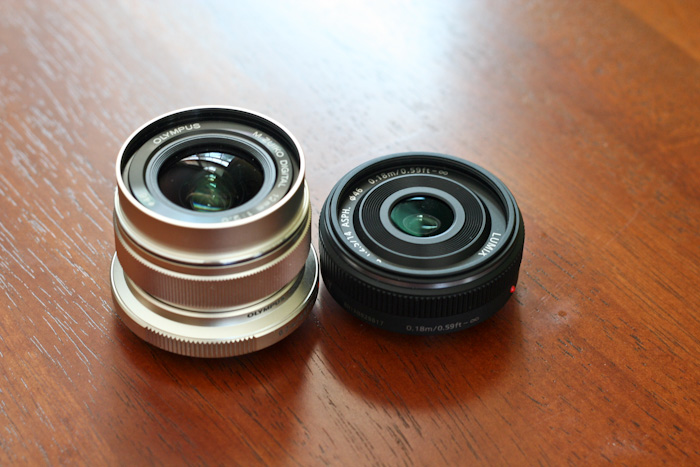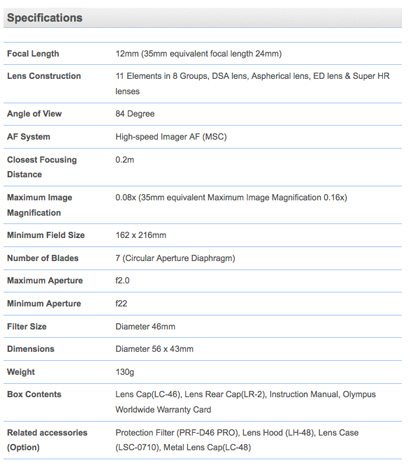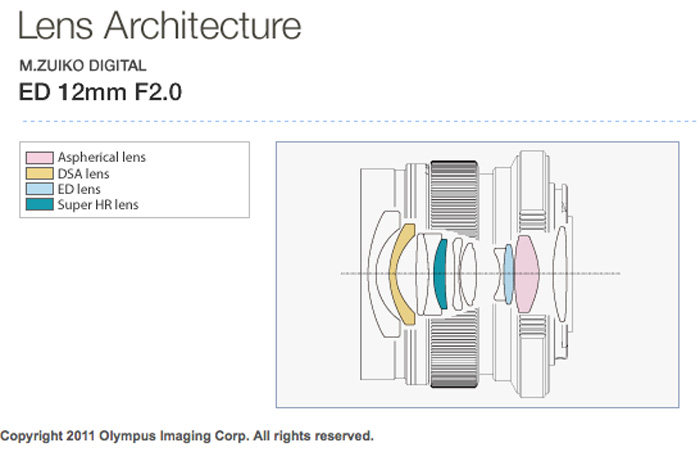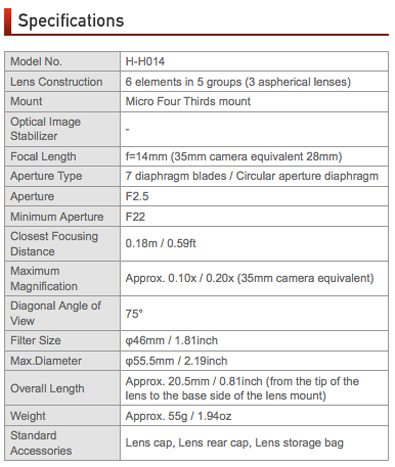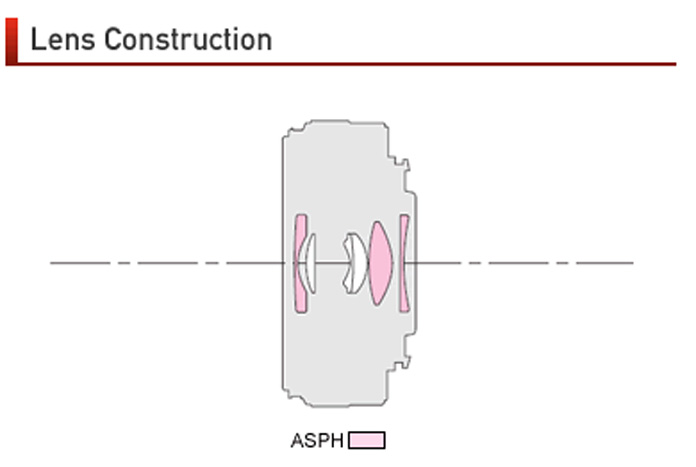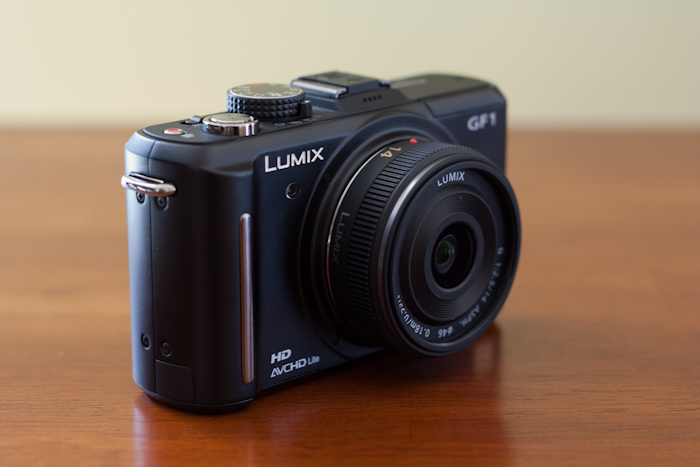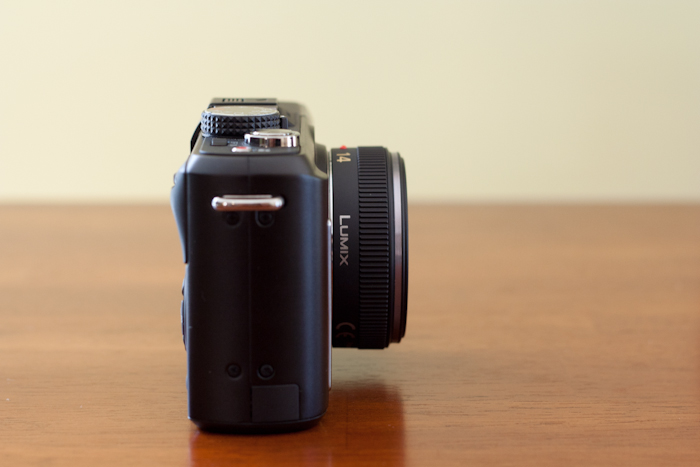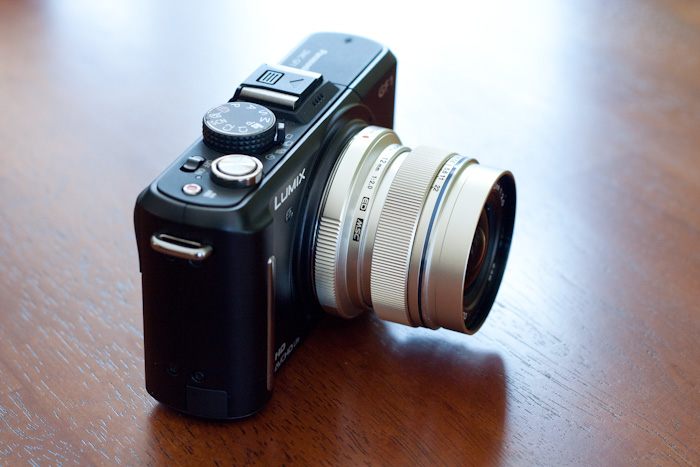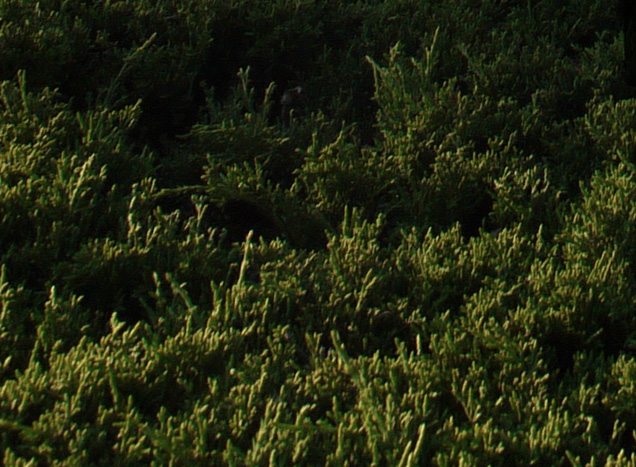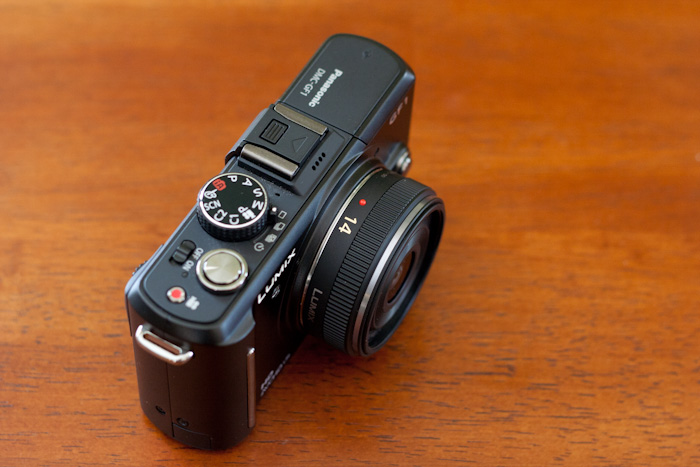Last Updated on 10/04/2011 by Mike Pouliot
Over the past two to three years, the Micro Four Thirds (M43) system has morphed from an uncertain new category into a serious alternative to consumer DSLRs. As this segment grows, manufactures, mainly Olympus and Panasonic, have started to provide users with more lens options, but more importantly, they are producing higher quality lenses. Because of the relatively small sensors size, M43 systems have to deal with a 2x crop factor. Because of this, Olympus and Panasonic have to produce very wide lenses to provide users with a field of view that is similar to what their used to using with SLRs (e.g. 24mm, 35mm, 50mm, etc.). In this review, we are going to compare two M43 wide angle primes, the Olympus 12mm f/2 and the Panasonic 14mm f/2.5.
Specs
Olympus
Panasonic
Looks & Build Quality
While there is only a 2mm difference between these two lenses, you wouldn’t know it by simply looking at them. The Panasonic is a tiny little thing, both in size and weight while the Olympus is quite a bit larger and feels much more substantial in your hand.
Panasonic
I have no idea how Panasonic was able to construct a lens like the 14mm f/2.5 pancake lens, this thing is so tiny! It is, by far, the the lightest and most compact M43 lens you can buy. Because of this compact dimensions and ultra lightweight body, the 14mm f/2.5 is a wonderful travel lens for you M43 body. When attached to my GF-1, you hardly know it’s there. The all black finish and gold lettering make the 14mm f/2.5 look right at home on the GF-1.
To keep the weight down, Panasonic opted to construct the 14mm f/2.5 of plastic. Does it feel cheap? No, I personally think it feels rather well constructed. I wouldn’t want to drop it down a flight of stairs, but then again, would you throw any lens down a flight of stairs? It has a focus ring that is smooth and big enough for me to work with my lanky fingers but I hardly ever use manual focus with my GF-1 as the AF is very quick and accurate with this lens. There really is not much else you can say about the 14mm f/2.5. Panasonic opted for compactness and simplicity with the 14mm, and I think that decision will sit well with most M43 users.
Olympus
While the Panasonic is compact and light, the Olympus 12mm f/2 is extremely well built and solid. It looks like is should be on the front of a Leica, not a M43 body. The lens is finished with a champagne colored metal and a blue ring adorns the top of the lens, similar to Canon’s red L ring. Nicely done Olympus.
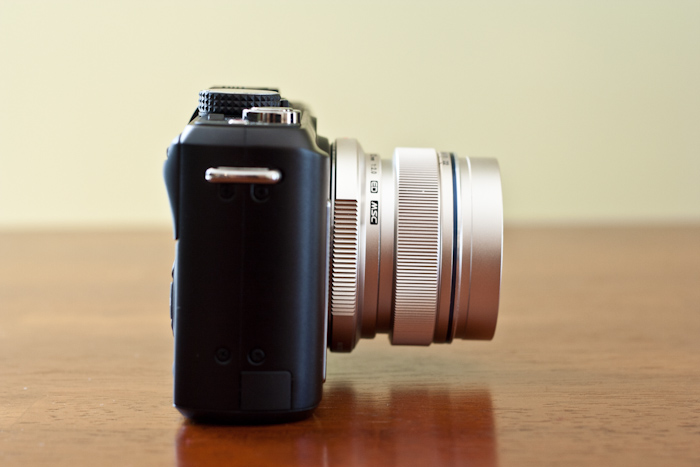
Forgoing the plastics that make up the majority of the Panasonic, Olympus opted for and all metal construction for the 12mm. Because of the all metal construction, the Olympus 12mm feels wonderful in your hand but the weight may bother some users. The difference in weight is especially noticeable when switching between these lenses. The Olympus’ weight and length actually makes my GF-1 heavy and slightly off balance when in use. Replace the Olympus 12mm with the Panasonic 14mm f/2.5 and you would think the GF-1 just lost a few pounds.
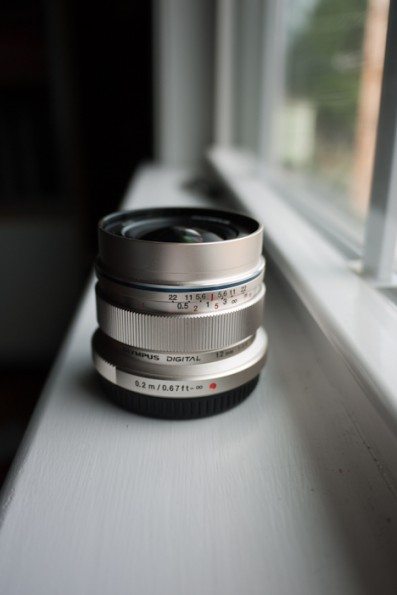
The real showstopper with the Olympus is the focus ring. It has a smooth and buttery action, but that’s not what makes this special. At first look, the focus ring seems like any other focus ring, but pull it towards the body of the camera and it will slide down into manual mode—which is pretty sweet. After you slide down the focus ring, you will see distance scales like in old manual focus lenses. Any photographer that is a fan of zone focusing should be very excited with this feature.
AF Performance

Auto focus performance with both lenses is very impressive. Even in low light, each lens snaps into focus in less than a second. One thing that aids in the speed of these lenses is there are no external moving parts meaning the front element does not move. The Panasonic 20mm f/1.7’s front element does move which means slower AF speed when compared to the 14mm. In addition to slower AF speeds, moving front elements make lenses more prone to dust and gunk into your lens.
On my Panasonic GF-1, I would have to call it a draw but slap these lenses on a new E-P3 and it would be a completely different story, the Olympus 12mm would simply slaughter Panasonic’s 14mm. Check out our review of the E-P3 and 12mm combo. Also take a look at our 12mm review on the EP2.
Image Quality
Build quality and AF speed are important, but what about image quality? Can Panasonic’s 14mm really keep up with Olympus’ new 12mm lens that costs more than three times as much. In short, yes. The images produced from these lenses are very compatible but there are a few slight difference between these lenses.
Bokeh
Unlike sharpness or color accuracy, bokeh is a very subjective lens characteristic and I honestly think this one is a tossup. The Olympus has the benefit of having a maximum aperture of f/2 while the Panasonic maxes out at f/2.5. Not a huge difference (see below), especially with a wide angle lens and a sensor of this size, but a difference nonetheless. If someone put a gun to my head and made me choose one, I think I would actually the give honors to the Panasonic if both were being shot at f/2.5. Take a look at the images below. I find trees on the left and the out of focus green area to be more pleasing from the Panasonic. Again, there is no right or wrong answer here, it’s all personal preference.



Color and Saturation
Like bokeh, this is a tough call. Both produce deep rich colors and allow the user to take full advantage of the M43 sensor’s dynamic range. Take another look a the images of the flower. I honestly feel like this is a toss up. What do you think? If I had to pick a winner, I think it would go with the Olympus. The greens look more natural with the Olympus, the Panasonic looks a bit orange but this could easily be adjusted with a tweak to the white balance.
If you look at the rest of the comparison images in this review, you will see that the colors produced by these lenses are very similar.
Sharpness/Detail/Contrast
Again, this is a close one. Both lenses produce images with lots of detail in the center of the frame, especially when stopped down, but the Olympus trumps the Panasonic in the corners. Take a look at the bushes in the bottom corner of the shots below. The Olympus has much more detail in the corner than the Panasonic.


Below are center crops from the images above. Not surprisingly, both look very good but I actually think the Panasonic is slightly sharper and resolves more detail in the center than the Olympus although it could be that extra 2mm of reach, it’s debatable. While the Panasonic may be very sharp in the middle, the Olympus is slightly (and I do mean slightly) sharper and more contrasty across the image which is what will matter to most.


Color Fringing and Distortion
Note: The GF-1 actually compensates for color fringing and distortion in camera when shooting JPEGs. Because of this, all images for this test were shot in RAW for both lenses.
Both of these lenses mange color fringing surprisingly well. So well in fact, that I spent several minutes scouring images for traces of color fringing…nothing. This is extremely impressive considering how wide these lenses are. Distortion, on the other hand, is an issue. Both lenses display a noticeable amount of distortion which has to be expected with lenses that are this wide. Like I stated before, the Panasonic will actually compensate and correct this in-camera when shooting JPEGs but that isn’t helpful unless you have a Panasonic M43 body. Not surprisingly, the Olympus seems to have slightly more distortion but that has to be expected due to it being a wider lens. But honestly, considering their size and focal lengths, I’m very impressed with how well both of these lenses manage distortion.
Conclusion
As you can see from the images above, both lenses produce excellent images and I wouldn’t hesitate to recommend either to any M43 user. I found performance with the Olympus 12mm and the Panasonic 14mm to be very similar when shooting with my GF-1. With that being said, there are reasons to buy one over the other, see below.
Olympus

Let’s be honest here, the Olympus is expensive. It’s more than double (closer to triple) the price of the Panasonic 14mm. The lens preforms slightly better than Panasonic’s 14mm, but that’s a hard price to swallow. Most photographers use M43 as an alternative to lugging around their DSLR which means M43 is not their primary kit. For many, $800 for one wide M43 prime lens is going to be out of the question. So why buy the 12mm? Well, I can answer that question with one word/model number, the E-P3. Check out our review of the E-P3 with the 12mm lens and make sure you check out the video of the focus speed, you will be amazed. The Olympus 12mm and E-P3 work together to have one of the fastest focusing speeds I have seen in ANY camera, including DSLRs.
So, if you are looking to get into M43 and the E-P3 is on your list, you should strongly consider buying it paired with the 12mm f/2, I think you will be more than happy with that combo.
Panasonic
This ultra compact pancake lens is a freak of nature. How can something so compact produce photos that look this good? Yes, the corners are a bit soft and distortion is present, but it manages to keep up with the Olympus 12mm in almost every way for a fraction of the price. If you already have a M43 body (that isn’t an E-P3) and you are looking for a wide prime, the Panasonic 14mm f/2.5 should be at the top of your list.
Personal Note

Lately, I’ve been adding a “Personal Note” section to my posts. When I read objective reviews, I also like to know what the writer personally thinks about each lens and I always want to know which one would get their money. Let me know what you think about this section.
As I stated early on in this review, I own the GF-1 and 14mm f/2.5. Personally, I think the 14mm is a great value for the money and I would choose it over the 12mm simply because of the 12mm’s price. You could buy the Panasonic 14mm f/2.5 and the Panasonic 20mm f/1.7 (my favorite M43 lens) for less than the 12mm f/2. That’s a solid kit and you’d only need to add something in the telephoto range which can be had for a less money than the primes. That’s my personal opinion, take it for what it’s worth.
More Comparison Images
A few readers asked to see more photos and we here at The Phoblographer like to give our readers what they want. So, below are a few more comparison shots from the Olympus 12mm and the Panasonic 14mm. Enjoy!






Please Support The Phoblographer
We love to bring you guys the latest and greatest news and gear related stuff. However, we can’t keep doing that unless we have your continued support. If you would like to purchase any of the items mentioned, please do so by clicking our links first and then purchasing the items as we then get a small portion of the sale to help run the website.


